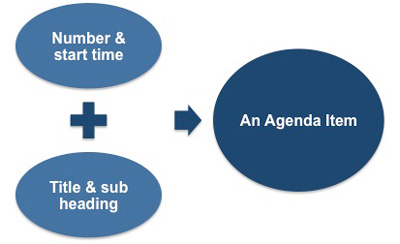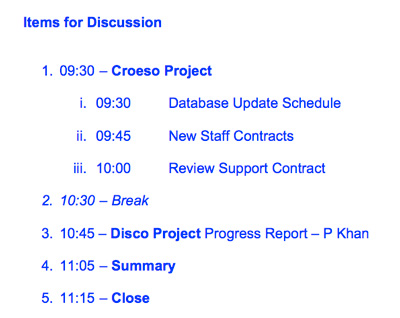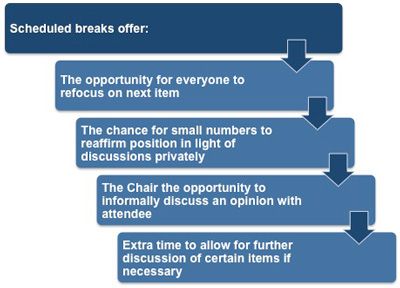Meeting Agenda Sample
Each of your meeting agenda items should have the following characteristics:
 |
Item number
This allows everyone to refer to that item on the agenda during the meeting.
Start time
This time enables the meeting chair to control and manage discussion time and to reaffirm the allocated number of minutes available to discuss this issue. (The start time of the next agenda item is also the end time of the previous one.) This timeframe helps participants to self-regulate and use the time more effectively.
Title and sub-title
Each agenda item should be clearly specified and meaningful to the attendees. If an item has several aspects to be discussed then each of these elements should be listed as sub-headings, each with its own specified time limit.
This is illustrated by the Croeso Project in the following example.
 |
When compiling your agenda there are certain important considerations you must take into account:
• Will everyone who is at the meeting understand what is meant?
• Is it clear whether action is required?
• Is it specific enough to limit the scope of the discussion?
• What outcome are you expecting from this agenda item?
• Is it short and simple enough to fit into one or two lines?
In the example above it is clear to all attendees that for Item 3 (The Disco Project) P. Kahn will lead the discussion and not the Chair as with all the other items on this agenda. If this individual is unknown to attendees then a short resume of their expertise should be included with the necessary background information.
Scheduling Meeting Breaks
If your meeting needs to exceed 45 minutes, it is advisable to include breaks in your agenda to ensure that participant concentration is maintained. It also refocuses the mind-set of the attendees to the current item in a more positive and productive manner than before the break.
 |
There are also some less obvious benefits of including breaks in your agenda. For example, they offer a small number of individuals the opportunity to chat through and reaffirm their standpoint on an issue, as prior discussions may have highlighted a new or different perspective that they had not assessed the implications of. This can avoid tensions arising, because no one feels comfortable having these conversations as part of the main body of the meeting.
This ability to seek clarification is also offered to the Chair who can use scheduled breaks to informally discuss any issue that may be contentious and assess how best to handle the next item in order to arrive at an informed decision.
Your Chair also has the ability to use the scheduled breaks to accommodate extensions of certain discussions. This will enable the meeting to arrive at more informed decisions.
This Meeting Agenda Checklist outlines the five key areas you need to address to produce an effective agenda. This Meeting Action List Template enables you to record actions, responsibilities and timescales that result from the meeting.
You may also be interested in:
Meeting Agenda Format | Writing a Meeting Agenda | Agendas for Short Meetings.



